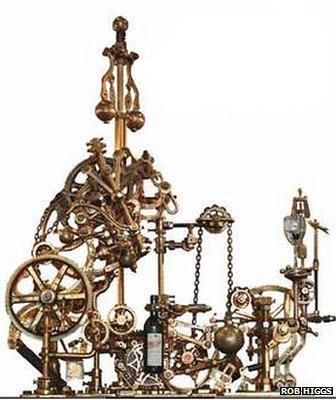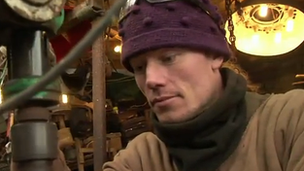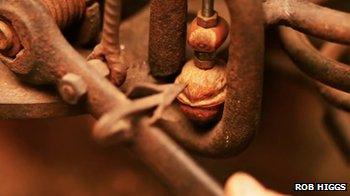How to build a bigger, better corkscrew
- Published
Junkyard genius's crazy nutcracker
There are many man-made objects in the world in need of improvement. And there are a small number that, through use and experience, have become stripped to their essence and as a result are hard to improve upon. Or so you might think.
One such object is the traditional corkscrew. At its most primitive it displays an almost iron-age simplicity.
It is a helix of metal anchored in a rounded wooden handle. To grasp it is to discover how to use it. And it is elegant in pursuit of that singular purpose.
And yet, and yet, for some that simplicity is a spur. A goad to explore just what the corkscrew would be if it were first conceived in an age that venerated machines or their makers.

Mr Higgs's mechanical corkscrew weighs as much as some cars
For mechanical sculptor Rob Higgs similar thoughts started a journey that ended at the other end of the spectrum from the simple, streamlined object we all have lurking in our kitchen drawers.
Mr Higgs' corkscrew is not slim, it cannot be held in the hand and the only similarity it shares with its namesake is that it does remove corks from bottles.
It weighs more than three-quarters of a tonne, is a convoluted hedge of 382 moving parts including gears, pulleys, levers, springs and probably flanges that is 1.6m (5ft 3in) tall at its highest point, is cast from brass and is a glorious sight to behold when set in ponderous, whirring, clanking motion.
Not bad for someone who, he claims, became a mechanical sculptor pretty much by accident.
"I've no formal training," he told the BBC.
Mr Higgs is now settled in Newquay, Cornwall, living in a 1930s boat that he rebuilt himself. Making those living quarters was his first big project but, he admits, his dad's family were engineers and his youth was spent in and around people who liked to create, hack and tinker, and were good at it.
Mr Higgs had no desire to follow the formal route to being an engineer because it would mean he ended up in an office, sitting at a computer and he would never get his hands on the finished thing. And things are what he loves.
Living in Cornwall and putting his houseboat to rights led Mr Higgs to discover and get to know others who did similar work.
That contact got him tinkering and continuing to create once the houseboat was done.
Now the boat is his home and the yard his studio, filled with all the bits, bobs, iron, brass, bric-a-brac and spare parts that he uses in his work.
"Other people said there was quite a lot of work doing it though I was just making stuff for a laugh," he said.
"They said I could sell it through the Eden Project and because there was a route it became my career."

Mr Higgs says he likes going outside his "comfort zone" when creating his contraptions
The rise and rise of steampunk - the retro-futuristic style - and its love for copper, brass, gears and automata has helped his prospects as have movies such as Hugo.
The result is that for the last few years he has not had to sell his creations in shops at tourist attractions but has instead worked almost entirely to commission.
He has produced props for theatre productions and films, or sculptures for display in museums, visitor centres and other buildings.
His latest work in progress is a submarine, complete with half-tonne propeller, that will take centre stage in a children's playground.
He treats every creation as a challenge, daring himself to go far beyond any simple assumption about how a device, such as a corkscrew or nutcracker, external, is expected to work.
"It's the unknown element and excitement of it," he said, "going outside the comfort zone on each job teaches me a specialist skill."
He's as rigorous as any formal engineer in that he draws up designs for each work but, he said, the finished device can look very different to the initial conception.
He also makes each one out of scrap and junk, many of which are parts or pieces of other junked mechanical objects.
That's important, he said, because it makes something of what is discarded. Often key components are tools that are no longer used as tools but Mr Higgs can find a way to put them to use again.

Another of Mr Higgs's contraptions finds a novel way to crack walnuts
Also, he thinks, his creations have become more valued, and valuable, as society has less and less to do with the mundanely mechanical.
Just think of the last time you had to wind a handle to get something done.
"As the skills become less and less of something that you can see everyday, it becomes a speciality," he said. And he's in no doubt that he is a bit special.
"I feel like I'm lucky every day," he said. "I have to pinch myself that I can get paid regularly to do this."
- Published14 March 2013
- Published21 February 2013
- Published31 August 2012
- Published30 July 2012